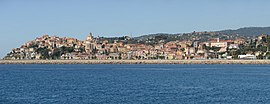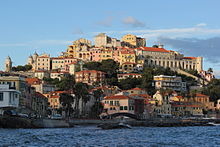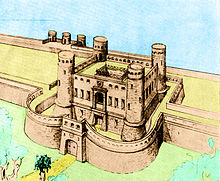Imperia (Liguria)
| Imperia | ||
|---|---|---|

|
|
|
| Country | Italy | |
| region | Liguria | |
| province | Imperia (IM) | |
| Coordinates | 43 ° 53 ' N , 8 ° 2' E | |
| height | 10 m slm | |
| surface | 45.26 km² | |
| Residents | 42,614 (Dec. 31, 2019) | |
| Population density | 942 inhabitants / km² | |
| Post Code | 18100 | |
| prefix | 0183 | |
| ISTAT number | 008031 | |
| Popular name | Imperiesi | |
| Patron saint | San Leonardo | |
| Website | www.comune.imperia.it | |

|
||
Imperia ( also: Impè-ia in Ligurian ) is an Italian port city with 42,614 inhabitants (as of December 31, 2019) in Liguria on the Riviera di Ponente and capital of the province of Imperia . It is located on the Roman road Via Aurelia , which connects the Italian capital Rome with the French Arles .
Oneglia ([ ɔːˈnɛʎa ]; old dialect name Ineja ) to the east is the more modern part of the city with its commercial harbor and food industry (mainly olives and pasta ). The old Porto Maurizio (old dialect name Pòrto Moriçio ) with its marina in the west of Oneglia is as angled as the 25 kilometers to the west of Sanremo and has some monumental historical buildings. Whereas in the past fishing and tourism dominated the cityscape, today there is a shift towards the service sector . These two districts are divided by the river Impero , which gives the city its name. The administrative merger of the two communities and the surrounding villages took place in 1923.
Ligurian is generally spoken in Imperia . However, there are some differences in terminology and pronunciation between the districts of Porto Maurizio, where the dialect is more similar to Intemelio , and Oneglia, where the Piedmontese rule has left its mark on accent and vocabulary. With the onset of increased internal migration from southern Italy at the beginning of the 1960s, the dialect was interspersed with many Italian terms and is now largely restricted to the older population group.
geography
The city consists of the two formerly independent districts Oneglia and Porto Maurizio as well as the surrounding villages Artallo, Borgo Sant'Agata, Borgo d'Oneglia, Cantalupo, Caramagna Ligure, Castelvecchio di Santa Maria Maggiore, Clavi, Costa d'Oneglia, Massabovi, Moltedo Superiore, Montegrazie, Oliveto, Piani, Poggi and Torrazza.
Oneglia, east of the Impero, is the largest and highest district and extends into the short alluvial plain on the left bank of the Torrente Impero estuary . The center is the Piazza Dante , from which some of the modern main streets start. In contrast to Porto Maurizio, the more industrialized district is characterized by an architecture shaped by Piedmontese influences. This is particularly evident in Via Roma and Piazza San Carlo di Torino .
Porto Maurizio, in the west of the Impero, is located on a headland to the left of the mouth of the Caramagna torrent and extends along the coast of the Ligurian Sea . It has a mainly residential and tourist character and has a large number of picturesque alleys ( Vicoli and Creuze ) and magnificent palazzi.
The surrounding landscape in the center of the Riviera of Flowers is characterized by short valleys that run orthogonally to the coast. A large number of settlements have developed in these areas, the original structure of which has remained almost completely unchanged to this day.
The olive tree cultures that were introduced in the 12th century left a deep mark on the history of the imperial territory, just as floriculture and tourism were to do in the centuries that followed. The olive trees cultivated on terraces and the characteristic dry stone walls are still the dominant element in the landscape today.
The distance to the northeastern Genoa is about 120 kilometers, Ventimiglia near the border with France is about 50 kilometers to the west.
According to the Italian classification for seismic activity, Imperia was assigned to zone 2. This means that earthquakes occur with medium to high frequency in the region.
History of Oneglia and Porto Maurizio

In the 11th century Oneglia came under the rule of the Bishops of Albenga . Porto Maurizio became a fiefdom of the Benedictine order under Olderico Manfredi , ruler of the Marca Turin, and his daughter Adelaide. In 1091 the Counts of Clavesana , heirs of Adelaide Manfredi, took over the rule of Porto Maurizio and proclaimed a republic (with San Maurizio, San Giorgio di Torrazza and San Tommaso di Dolcedo). San Maurizio became the patron saint. Genoa subjugated Porto Maurizio in 1184 against the continued resistance of its inhabitants. In the war between Porto Maurizio and Oneglia 1200, the Republic of Genoa intervened . The Impero then became a border river and from then on belonged to Porto Maurizio. In 1241 Porto Maurizio became the Genoese vicar seat for the Ponente. On January 30, 1298, the Bishops of Albenga Oneglia sold for 11,000 lire to the Genoese Nicolò and Federico Doria .
In 1576 Emanuele Filiberto of Savoy bought Oneglia the Doria and made it Savoy's bridgehead against the Genoese Porto Maurizio. Oneglia was besieged and conquered by Spain in the 17th century. In 1745 France occupied Porto Maurizio, and in 1746 Piedmont occupied the place. Oneglia was sacked by the French Revolutionary Army in 1794. In 1805 Porto Maurizio fell back to France. With the union of Savoy and Liguria, both cities became part of the Kingdom of Sardinia-Piedmont in 1815 . Oneglia becomes the provincial capital. In 1841 it received the title "città fedelissima" of the Kingdom of Sardinia-Piedmont. In 1860 Porto Maurizio became the provincial capital (until 1923). Together with all of Liguria, Oneglia and Porto Maurizio became part of the Kingdom of Italy under Vittorio Emanuele II of Savoy in 1861 . On October 21, 1923, the city emerged from the union of the two formerly independent communities Oneglia and Porto Maurizio.
politics
Despite its small size, Imperia has always been a scene of lively political and cultural exchange. The voting behavior of the Imperiesi can largely be described as centrist, and political phenomena have often been transferred from Imperia to the national level. During the Biennio rosso , numerous strikes and demonstrations took place in Oneglia. In addition, many partisans , including the author of the partisan song Fischia il vento Felice Cascione , come from this district. Later, in the 1960s, the student movement was active in the city's schools.
The acting Lord Mayor has been Carlo Capacci since 2013 . For about a decade, the voting behavior of residents has shifted to the right-wing political spectrum and Imperia has since been considered a stronghold of the political right.
Culture and sights
The Cineforum di Imperia , a film forum with now 800 members and organizer of the VideoFestival Imperia , has existed since the 1960s .
In 1963 Emilio Lepre founded the Coro Mongioje di Imperia . As a result, the direction of the choir passed to Guido Gorlero and, since 1977, to Elio Guglieri.
Since 2005 there is also a control committee in Imperia for the sighting of paranormal phenomena . It refers to the Comitato Italiano per il Controllo delle Affermazioni sul Paranormale (CICAP) founded by Piero Angela in 1989 .
Porto Maurizio
- The classicist basilica of San Maurizio was built by the architect Gaetano Cantone from 1781 to 1832 and is the largest church in Liguria.
- The old town is located on the Parasio hill.
- The Santa Chiara Monastery was founded in 1365, the current building dates from 1741.
Oneglia
- The gardens of Villa Grock are open to the public today, and the house of the famous clown is to become a conference and cultural center.
- The Museo dell'Olivo shows everything about olives .
- The church of S. Giovanni Battista was built in 1739–1762 by the architect Gaetano Amoretti , the facade was built in 1832–1838.
Economy and Infrastructure
Although very attractive, Imperia is not a tourist town, but an authentic small coastal town with a few industrial structures, which are becoming less and less important in favor of the leisure and recreation area. For example, one of the largest marinas on the coast is being built between Porto Maurizio and Oneglia.
Imperia is one of the main hubs for olive oil in Italy. In addition to the bulk bottlers of olive oil, there are a few small producers in the Imperia area with top-quality products in this area.
The ancient Roman road Via Julia Augusta ran parallel to the coastline from Genoa into what was then Gaul . Then there was the Via Marenca in the Middle Ages , which opened up the Ligurian hinterland and established a connection across the Alps to Piedmont . Most of the trade and traffic, however, was by sea.
The current traffic connections, however, are:
-
 the A10 motorway (Autostrada dei Fiori), leading from the French border, connects it to the rest of the Italian motorway network at Savona
the A10 motorway (Autostrada dei Fiori), leading from the French border, connects it to the rest of the Italian motorway network at Savona - the national road 1 Via Aurelia that the coastline following approximately congruent with the ancient Via Aurelia is
- the SS 28 state road towards Turin
- the Genova – Ventimiglia railway line , some of which is still being expanded.
The sea trade routes have seen a sharp decline in the last century, with an impact on the commercial port of Oneglia. The new marina, which is still under construction, should at least partially absorb this development. At the same time, the commercial port is being expanded between the bay of Oneglia and the mouth of the Impero river.
Twin cities
sons and daughters of the town
- Andrea Doria (1466–1560), Genoese admiral and prince of Melfi
- Leonhard von Porto Maurizio OFM (1676–1751), Franciscan minorite and preacher
- Carlo Amoretti (1741-1816), scholar
- Maria Amoretti (1756–1787), niece of Carlo Amoretti, well-known lawyer and the first woman to have a doctorate in Italy
- Edmondo De Amicis (1846-1908), writer
- Giulio Natta (1903–1979), chemist, Nobel Prize winner 1963
- Nino Lamboglia (1912–1977), archaeologist
- Ismaele Mario Castellano (1913-2007), Archbishop
- Luciano Angeloni (1917–1996), archbishop and diplomat
- Alessandro Natta (1918–2001), brother of Giulio Natta, politician and general secretary of the Communist Party of Italy (PCI) from 1984 to 1988
- Luciano Berio (1925–2003), composer, one of the pioneers of electronic music
- Claudio Scajola (* 1948), politician
- Carlo Gentile (* 1960), modern historian
- Cristiano Salerno (* 1985), racing cyclist
See also
Web links
- Website of the Province of Imperia (Italian)
- Museo dell'Olivo (German)
- Official website of the city (Italian)
Individual evidence
- ↑ Statistiche demografiche ISTAT. Monthly population statistics of the Istituto Nazionale di Statistica , as of December 31 of 2019.
- ↑ As stated on the corresponding page on Wikipedia Ligure https://lij.wikipedia.org/wiki/Pòrto_Moriçio
- ↑ Ordinanza PCM n.3274 of March 20, 2003







